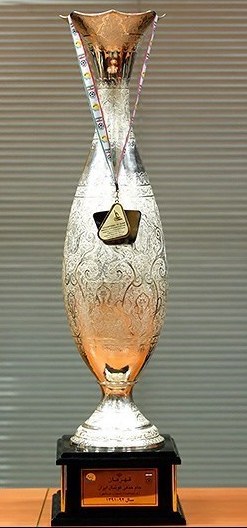|
2013–14 Hazfi Cup
The 2013–14 Hazfi Cup was the 27th season of the Iranian football knockout competition. Sepahan was the defending champion, but was eliminated by Sanat Naft in Round of 32. The competition started on 4 September 2013 and ended on 14 February 2014. Tractor won the title with defeating Mes Kerman in the final. Participating teams Totally 103 teams participate in the 2013–14 season. These teams are divided into four main groups which are introduced here. Group 1 ''(Start their matches from the first round)'' * In total 26 teams (24 teams from 24 different provinces in Iran (each province: one), 1 additional team from Tehran province, 1 team from Kish). * None ('' Alborz Province'') * Gandomkaran Moghan ('' Ardabil Province'') * Azar Kowsar Tabriz ('' Azerbaijan Sharqi Province'') * Pas Ganaveh ('' Bushehr Province'') * Moghavemat Shahrekord ('' Chahar Mahaal and Bakhtiari Province'') * Shahrdari Kelachay ('' Gilan Province'') * Talar Vahdat Hamedan ('' Hamadan Provin ... [...More Info...] [...Related Items...] OR: [Wikipedia] [Google] [Baidu] |
Hazfi Cup
Hazfi Cup (Jām-e Hazfi; ) is the Iranian football knockout cup competition, run by the Iranian Football Federation. The Iranian football league was not held during the 1980s, hence the winner of Hazfi Cup represented Iran in the Asian Club Championship. After the revive of the league system, the champion of Iranian league qualified for Asian Club Championship and the winner of Hazfi Cup ran for Asian Cup Winners' Cup. However, the Asian Cup Winners' Cup merged with the Asian Champions Cup in 2002–03 to form the AFC Champions League and Iran had been initially given two (and later four) slots in this competitions. The IRIFF decided to award one of Iran's AFC Champions League spots to the winner of the Hazfi Cup, and since then, the winners of Hazfi Cup have always been allocated a spot in the AFC Champions League. The competition was founded in 1975 as Pahlavi Cup but after revolution continued as Hazfi Cup. Esteghal is the most successful club with seven titles. Format ... [...More Info...] [...Related Items...] OR: [Wikipedia] [Google] [Baidu] |
East Azerbaijan Province
East Azerbaijan Province ( fa, استان آذربایجان شرقی ''Āzarbāijān-e Sharqi''; az-Arab, شرقی آذربایجان اوستانی) is one of the 31 provinces of Iran. It is located in Iranian Azerbaijan, bordering Armenia, Republic of Azerbaijan, Ardabil Province, West Azerbaijan Province, and Zanjan Province. The capital of East Azerbaijan is Tabriz. East Azerbaijan Province is in Regions 3 of Iran, with its secretariat located in its capital city, Tabriz. Geography The province covers an area of approximately 47,830 km², it has a population of around four million people. The province has common borders with the Republic of Azerbaijan, Armenia and Autonomous Nakhchivan in the north, West Azerbaijan in the west, Zanjan in the south, and Ardabil in the east. A fine network of roads and railways connects East Azerbaijan to other parts of Iran and neighboring countries. The highest point in East Azerbaijan is the volcanic peak of Sahand Moun ... [...More Info...] [...Related Items...] OR: [Wikipedia] [Google] [Baidu] |
North Khorasan Province
North Khorasan Province ( fa, استان خراسان شمالی, ''Ostān-e Khorāsān-e Shomālī'') is a province located in northeastern Iran. Bojnord is the capital of the province. The counties of North Khorasan Province are Shirvan County, Esfarayen County, Maneh and Samalqan County, Raz and Jargalan County, Jajarm County, Faruj County, and Garmeh County. North Khorasan is one of the three provinces that were created after the division of Khorasan in 2004. In 2014 it was placed in Region 5. History Greater Khorasan has witnessed the rise and fall of many dynasties and governments in its territory throughout history. Various tribes of Persians, Arabs, Turks, Kurds, Mongols, Turkmens, and Afghans have brought change to the region time and time again. Ancient geographers of Iran divided Iran into eight segments, of which the largest was the territory of Greater Khorasan. Esfarayen, among other cities of the province, was one of the focal points for settlement by ... [...More Info...] [...Related Items...] OR: [Wikipedia] [Google] [Baidu] |
Talar Vahdat Hamedan Hamedan F
Talar դալար is a Western Armenian name for females. It's meaning is symbolic of the Evergreen Tree. The talar or talaar ( fa, تالار) is the throne hall of the Persian monarch that is open to the public. It includes a throne carved on the rock-cut tomb of Darius at Naqsh-e Rostam, near Persepolis, and above the portico which was copied from his palace. The ''Talar Divan Khaneh'' built by Fath Ali Shah is an example of this pavilion. Description In ancient times, as depicted in the sculptured facade of Darius tomb at Persepolis show, the talar had three tiers, with Atlant statues upholding each. This design typified the subject-people of the monarch. The talar built by the Qajar dynasty as part of the Royal Palace is a spacious chamber with flat ceiling decorated with mirror panels. The walls are also decorated with mirror work called ''aineh-kari'', which produced numerous angles and coruscations. See also *Architecture of Iran Iranian architecture or Pe ... [...More Info...] [...Related Items...] OR: [Wikipedia] [Google] [Baidu] |




